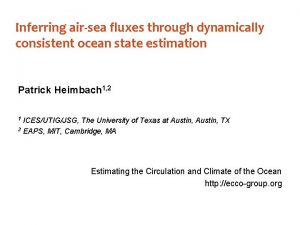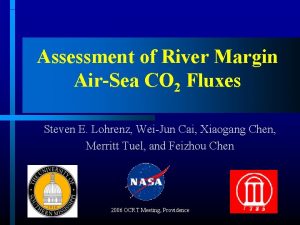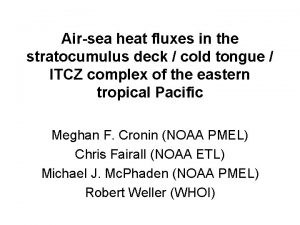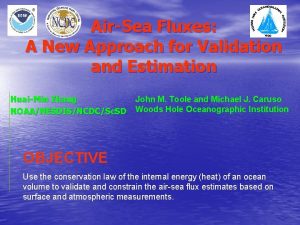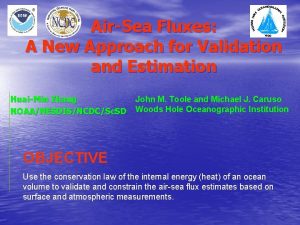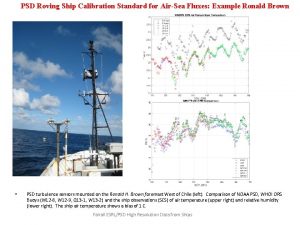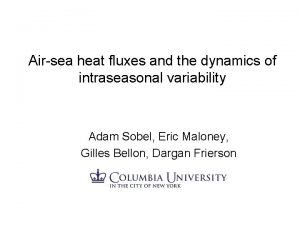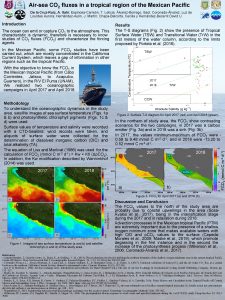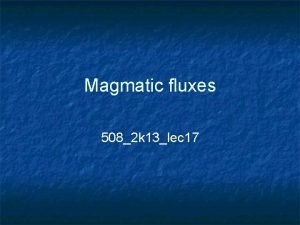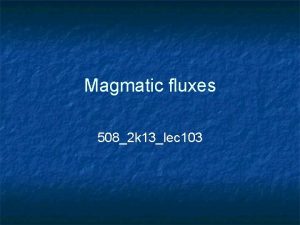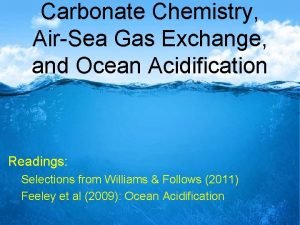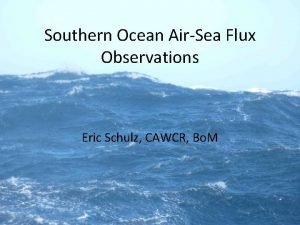OCEAN RESPONSE TO AIRSEA FLUXES The main mechanism

















- Slides: 17

OCEAN RESPONSE TO AIR-SEA FLUXES The main mechanism: mechanical and convective mixing in the surface layer. Both work to provide a deepening of the upper ocean mixed layer. Temporal seasonal evolution of the surface mixed layer Oceanic and atmospheric mixed layers in contact

2 non-dimensional parameters: Simple mixed layer model: T Ts h TH z H Integration within surface mixed layer gives: Vertical heat exchange equation: Integration within surface mixed layer gives: Surface net flux

Integration from h to H: This integral can be written as where :

Ocean circulation characteristics from sea-air interaction parameters Meridional Transport of Heat (MHT): OCEAN VIEW: The total MHT can be represented as the sum of the advective and diffusive transports of heat: Advective MHT can be decomposed into an overturning component which corresponds to the transport of the zonally averaged circulation, and a gyre component which corresponds to the transport by horizontal gyres: where is the zonal averaging operator and prime stands for the variations of temperature T and meridional component of velocity v around the zonal mean.

If we know surface net heat flux, can we say something about the MHT? M 1=M 0+Q 1 M 2=M 1+Q 2= M 0+Q 1+Q 2 M 2 S Estimates of MHT can be obtained from the integration of Q 1 M 0 M 1 N Qnet = SW-LW-Qh-Qe over the ocean surface north of the latitude considered: where Mo is a boundary condition at the north which should be taken from alternative source (observations) or set to zero.

Being computed from a balanced surface flux, global MHT should converge to zero at the north and at the south Meridional heat transport shows basic features of the ocean general circulation, in particular it marks a specific role of the Atlantic Ocean, which indicates the northward MHT at all latitudes in both Hemispheres.

Ocean heat fluxes are influenced by the uncertainties (observational, sampling, etc. ), which impact on the zonal heat balance and propagate quickly to MHT through the integration: MHT, being physically a very important parameter, remains not very effective measure of the reliability of surface flux fields from a methodological viewpoint. Uncertainty of 10 W/m 2 for the Atlantic Ocean results in 0. 5 PW error in MHT at 20 S Closure of surface heat balance is not achieved in most climatologies of seaair fluxes: SOC (Josey at al. 1999): -30 W/m 2, negative MHT at 12 N in the Atlantic UWM (Da Silva et al. 1994) : - 30 W/m 2

Water mass formation characteristics from surface fluxes Ocean waters are characterized by temperature and salinity. Equation of state links density with these characteristics. Highest density Smallest density Surface density in the North Atlantic

Typical density of ocean waters are from 1023 to 1028 kg/m 3. For practical reasons ocean densities are estimated in relative units: = -1000 Surface water dz d. S Bottom water T, S – diagram is the ocean analog of P, T - diagram Volumetric T, S - diagram

To change the ocean water density we can: Ø provide heating/cooling by surface net heat flux (W/m 2) Ø provide precipitation/evaporation (m 3/sec) But how to know how many kilograms we added (or extracted) to (from) the ocean by the joint application of these two processes? The density flux (in fact a virtual mass flux since it has the unit of kg m 2 s-1) at the sea surface has been derived as: This flux is applied as a surface boundary condition to ocean models where CP is specific heat of sea water at constant pressure, 0 is a reference density of sea water, s is salinity in portions of unity, and are thermal expansion and haline contraction coefficients: = / T, = / S

North Atlantic surface density flux in kg/m 2 s, computed from the net flux and evaporation minus precipitation

Water mass transformation by surface density flux Integration in space and time of the density flux gives the transformation rate of waters at given density, F(ρ), which represents the time average over a period T (generally one year) of the density change of a unit water volume of density ρ which results from the action of the atmospheric forcing: where the function samples the density flux f over the area where waters of density are outcroping within the integration area . This quantity has a unit of kg s-1 and can be scaled with the unit density to be expressed in m 3 s-1 or Sv. In this form the transformation rate shows the volume of water of density 0 which is transformed, during a given period, into higher densities (F( 0) > 0) or lower densities (F( 0) < 0).


Thermal versus haline contributions ATL 6 ATL 1

Water mass formation: The formation rate was defined by the differentiation of the transformation rate, as the gradient of F(T, S) orthogonal to isopycnals: M(T, S) = -[ F(T, S)] / , = (S 0 S, T 0 T). Strong formation of STMW. Strong formation of LSW.

Overturning induced by the water mass transformation ATL 1 ATL 6

The role of surface fluxes in forming ocean circulation Incorrect position Correct position Importance of the correct location of the Gulf stream in relation to air-sea fluxes
 Convergent vs divergent plate boundaries
Convergent vs divergent plate boundaries Ocean ocean convergent boundary
Ocean ocean convergent boundary Ocean to ocean convergent boundary
Ocean to ocean convergent boundary Ocean ocean convergent boundary
Ocean ocean convergent boundary Chapter 15 ocean water and ocean life answer key
Chapter 15 ocean water and ocean life answer key Ocean to ocean convergent boundary
Ocean to ocean convergent boundary Ocean to ocean convergent boundary
Ocean to ocean convergent boundary Red ocean vs blue ocean
Red ocean vs blue ocean Natural and forced response
Natural and forced response What is natural response
What is natural response Primary immune response and secondary immune response
Primary immune response and secondary immune response Difference between will and going to future
Difference between will and going to future Tell more about the main idea
Tell more about the main idea Void main int main
Void main int main Hình ảnh bộ gõ cơ thể búng tay
Hình ảnh bộ gõ cơ thể búng tay Ng-html
Ng-html Bổ thể
Bổ thể Tỉ lệ cơ thể trẻ em
Tỉ lệ cơ thể trẻ em


















